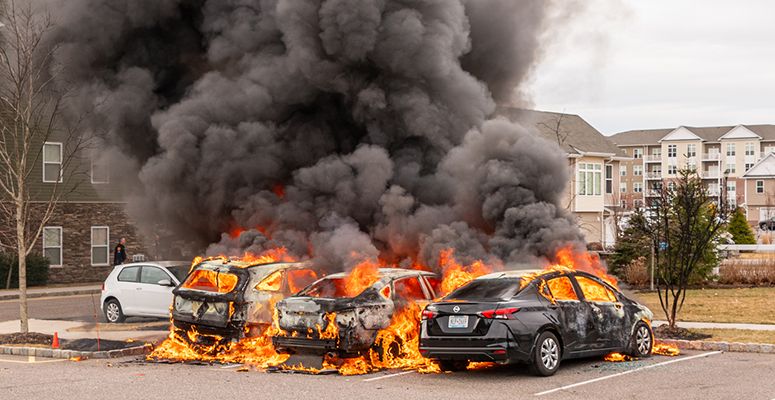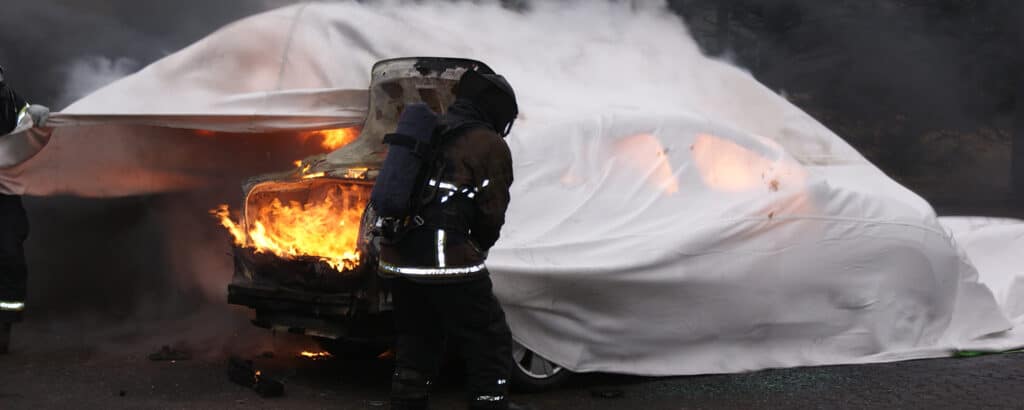EV fire Regulations

EV fire Regulations – In recent years, the global shift towards electric vehicles (EVs) has been nothing short of remarkable. Governments all around the world have introduced regulations and incentives to encourage the adoption of cleaner, more sustainable transportation options. However, during the rapid growth of the EV market, there seems to be one crucial part missing in the conversation: the lack of attention towards the prevention and containment of EV car fires.
As the number of EVs on the road is growing exponentially, so are the occurrences of EV car fires. Despite their green and environmentally friendly image, these vehicles are not immune to the risk of fires. The high-capacity lithium-ion batteries that power EVs, while efficient, can pose a significant fire hazard.
Growing need for EV fire Regulations
Slowly, Firefighting departments and governments are beginning to understand the importance of potential EV fires and their consequences. In the Netherlands, Fire Fighting Chief & Safety Director of region Haaglanden Esther Lieben calls EV car fires ‘Barely Extinguishable’ and advocates for electric car legislation and regulations.
In London, officials raised concerns over e-bikes and e-scooters as well. These small electric vehicles (LEVs), are becoming more and more popular as well. After a series of EV fires, causing the lives of three people, City Hall has written to the government raising “serious concerns” over the regulation of e-scooters and e-bikes.
Are there countries that already have EV fire Regulations?
In our search for existing regulations regarding the prevention and containment of EV car fires (worldwide), it wasn’t easy to find any.
In Europe, there is the UNECE R136, an international standard for the fire safety of Electric Vehicles. However, UNECE R136 focuses on battery safety, and not so much on how to control EV fires or how to prevent collateral damage. When it comes to this, there are only some guidelines here and there, but most of them still say one should use ‘lots of water’. While water is an important element, extinguishing a battery in thermal runaway is not possible, according to our own tests and when analyzing the incidents that have happened where the fire brigade tried to extinguish the battery with water. Water to cool the car; yes, water to spray in the form of a water mist to make the blanket light and prevent toxic vapour from flowing freely into the air; yes, water to dump the car in; yes. But trying to extinguish the battery will only see reignition after reignition.

Read here why just water is not the solution when it comes to EV car fires.
In the United States, there’s the National Highway Traffic Safety Administration (NHTSA), which is responsible for vehicle safety. NHTSA certainly has some guidelines for EV car fires, including requirements for battery pack construction and EV extinguishing. But again, no regulations or laws.
China Automotive Technology and Research Center (CATARC) is responsible for developing automotive standards in China. Just like Europe and the United States, they have a set of standards for EV fire safety but again: no actual regulations on how to control these fires.
The only country we’ve been able to identify who have successfully implemented regulatory controls is Singapore, which introduced UL2272 & EN15194 standards for LEVs (small electric vehicles). Through this, they’ve dropped the incident rate 33% overall, with personal mobility device fires dropping from 102 in 2019, to only 14 in 2022. While this regulation focuses on LEVs and may be easier in a smaller, high-density population like Singapore, the lesson is clear: regulation works.
Please note that laws and regulations are constantly evolving and while you are reading this, situations may have developed and improved in terms of controlling EV fires.
Best practices for fighting EV car fires
Often, norms and regulations are based on best practices. However, when it comes to fighting EV car fires, there is not nearly enough successful deployments to even start to talk about best practices. Incident after incident, we read about firefighters trying to extinguish a burning EV with water and failing. Or that they let the car burn out ‘ in a controlled way’ which is another way of saying that they do not have any idea what to do about it.
When it comes to deploying our Fire Isolator concept, we need to be clear that our goal is not to extinguish the car but to prevent collateral damage and win time. And our best practices come from the many live fire tests that us and our partners have performed. That is not a norm, but it sure works to minimize collateral damages when it is deployed quickly enough. So while governments and other bodies are figuring out what to do, we cannot be sitting on our hands. Incidents are happening right now, and we need to deal with the best way we can. In our opinion, this takes a mindset change and more tools to have available in order to be prepared.

How to control and prevent an EV car fire according to live tests and best practices
Controlling fires involving electric vehicles requires a specialized approach distinct from conventional vehicle fires. When an electric car is going up in flames, extinguishing it with just water is ineffective. That is why we created the Fire Isolator Concept for controlling EV fires and preventing collateral damage.
The Fire Isolator Concept consists of elements that, when you use them together, deliver the best results for fighting EV fires:
- Our Fire Blanket is used to isolate and control the fire and to prevent collateral damage.
- Aerosol units interrupt the thermal runaway and suppress the fire to lower the temperature.
- A water mist lance is to spray water onto the blanket in order to reduce toxic fumes and smoke and cool down the car.
- Thermal imaging camera to check the temperature.
- A dipping container.
Contact us for more information.

